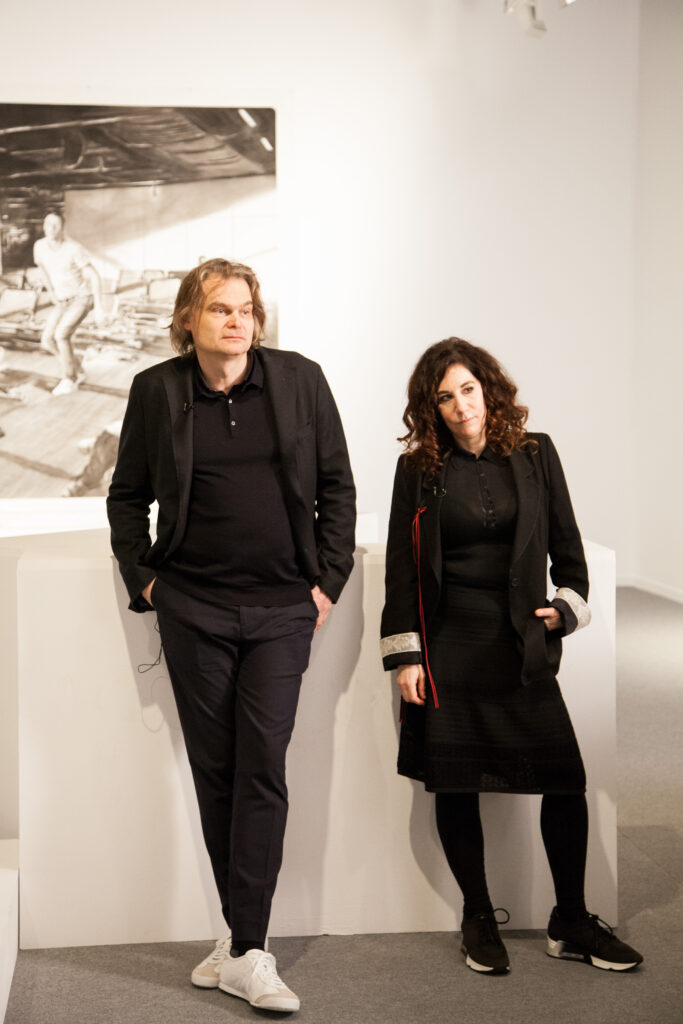Today the Gas Natural Fenosa Museum of Contemporary Art (MAC) is inaugurating the new exhibition This Is Not An Exit , from the artistic duo Muntean/Rosenblum formed by Austrian Markus Muntean and Israeli Adi Rosenblum.
Running until 16 September, this MAC show features recent works by the artistic duo, including two new series. The first, Self(ie) Series, conceptually confronts two different attitudes through portraits made from selfies. The second series uses images taken from viral videos with over 100,000 views on YouTube.
The title of the exhibition, This is not an exit, comes from the last line of Brett Easton Ellis’s novel American Psycho (1991) and refers to the goal of a parkour runner: to find a way through. Parkour is the training discipline of moving through obstacles in an urban or natural environment. Muntean/Rosenblum see parkour as similar to the work of contemporary artists, who must also imagine solutions to traverse and get through certain contexts, reflect, and make decisions.
Markus Muntean (Graz, Austria, 1962) and Adi Rosenblum (Haifa, Israel, 1962) have collaborated as an artistic duo since 1992. They live and work between Vienna, London and Tel Aviv. In 1995 they founded Bricks & Kicks, one of the first artist-run exhibition spaces in Vienna, which was in operation until 1998. Muntean/Rosenblum are internationally renowned for conceptual works that combine references to art history and popular culture. In 2001 the artistic duo were awarded the prestigious City of Vienna Prize for Visual Arts.
After showing at some of the most prestigious galleries in the world, like the Tate Britain in London and MoMA (Museum of Modern Art) in New York, Markus Muntean and Adi Rosenblum have come to MAC in A Coruña with their new project that sets reason against imagination: looking at things from a logical and balanced perspective while comparing them to a painful and chaotic present.
In the words of MAC Director Carmen Fernández Rivera: “These artists have developed a unique style and signature, appropriating a classical language to represent the subjects of their pieces while seeking ambiguity between absolute banality and spiritual pathos.”
This is not an exit: Parkour arrives to the Museum
Painting is one of the central aspects of Muntean/Rosenblum’s work, but it gets more complex from there: they also create drawings, text collages, photographs, and even large installations with sculptural elements that become the backdrop for performances and film projections. Their paintings mostly feature groups of young people in leisurely situations who seem to be bored or melancholic, fluctuating between the everyday and familiar, and the mysterious and ambiguous. These situations take place in bedrooms, public spaces, or in landscapes. The subjects are positioned to mimic the postures seen in fashion magazines and historical European paintings, from the Renaissance to the 19th century, so that ultimately these unfinished and ongoing situations appear theatrical, like a frame from a film.
Their paintings are framed by white edges as if part of a comic strip, and this sensation is enhanced by adding texts, not directly related to the scene, suggesting new levels of meaning. These phrases and aphorisms are taken from books by prestigious and prolific authors. This serves to literally underline that images should be read or interpreted, and to unseat the represented image from its place of hierarchical importance and replace it with the context of the specific installation.
Muntean/Rosenblum paintings are untitled, although they are identified by the beginning of the phrase that appears in them, in parentheses. The lack of more explanatory titles adds to their ambiguity. There are also colour paintings that are not entirely naturalist, as well as others in black and white. This is another reference to cinema and photography and gives the images, with their artificiality, an ambiguity in time.
Muntean/Rosenblum’s work is a kind of image science with no traces of historiographical, formalist, or iconographic simplifications. They are more interested in the meaning of things, considering the power of images and how they transform over time to constitute a labyrinth of collective memory. Muntean/Rosenblum see things from a rational and balanced perspective, combined with a complete identification with a sometimes chaotic and painful present, tightening the binds between reason and imagination. This tension, which gives their work its characteristic irresolution, and even discomfort, is also what makes it so attractive and stimulating.
Gas Natural Fenosa Museum of Contemporary Art (MAC)
The Gas Natural Fenosa Museum of Contemporary Art (MAC) is a multidisciplinary centre for contemporary culture. It is a dynamic, flexible and open space that combines exhibitions with public involvement and participation, in order to stimulate artistic creation in all areas of culture.
The Museum of Contemporary Art (MAC) has been establishing itself over the years not just as an exhibition venue but as a meeting place too for artists, art-lovers and the public, offering an extensive programme of cultural, educational, social and artistic activities that include temporary exhibitions, lecture series and workshops for schools and professionals.
The Gas Natural Fenosa Foundation has shifted its activities towards more social issues, which is why it has grouped all its cultural activities together and integrated them into the museum. The Museum of Contemporary Art is now part of the Gas Natural Fenosa Foundation, joining the ranks of the Gas Museum in Sabadell and the Bolarque Hydropower Plant Museum in Guadalajara.
